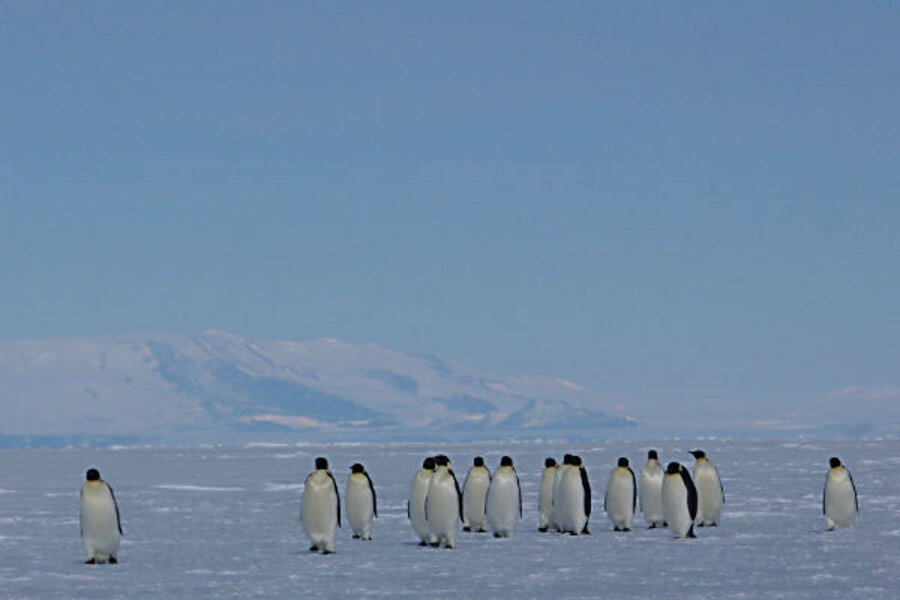East Antarctic ice shelves melting at surprising pace, study suggests
Loading...
Several small ice shelves along the East Antarctic coast appear to be melting at surprisingly high rates, some at rates comparable to those of shelves in West Antarctica, long a center of concern over the impact of climate change on the region's vast ice sheet and sea-level rise.
This is an unexpected result of a new study that documents the current status of ice shelves around Antarctica's coastline and the relative influence of the factors melting them.
It's unclear if the unexpected melt rates represent a trend. Conditions off the East Antarctic coast have been less-well studied than those off of West Antarctica, notes Stanley Jacobs, a researcher at Columbia University's Lamont-Doherty Earth Observatory in Palisades, N.Y., and a member of the team reporting its results in the current issue of the journal Science.
The cause also is unclear. But a lead suspect is relatively warm water that deep currents drive up onto the continental shelf. This water melts the ice shelves from underneath.
Still, "the numbers were a little bit larger than we were expecting – about the same as for shelves on the West Antarctic Ice Sheet," Dr. Jacobs says.
Ice shelves are the leading edges of glaciers that flow from the continental interior into bays and fjords. Friction with a bay's sides or with raised features on the sea floor turn the buoyant ice shelves into brakes that slow the pace at which the glacial ice upstream moves toward the sea. The last area where the ice touches sea floor is known as the grounding line.
Relatively warm water, driven by deep-ocean currents up onto the continental shelf, can melt the shelves from underneath. The water-induced melting also can cause the grounding line to retreat. Both are thought to contribute to the break-up, or calving, of the ice shelves into icebergs. On the shelf surface, meltwater can work its way into crevasses, freeze, and act as a wedge to help cleave the ice.
"Ice shelf melt doesn't necessarily mean an ice shelf is decaying; it can be compensated by the ice flow from the continent," notes Eric Rignot, a professor of earth science at UC Irvine and the study's lead author. "But in a number of places around Antarctica, ice shelves are melting too fast."
Excessive breakup of the shelves can accelerate the flow of continental ice to the sea, contributing to sea-level rise.
Some of the most dramatic break-ups have occurred along the Antarctic Peninsula, a region of the continent that has seen some of the most pronounced warming on the planet – warming most climate scientists attribute to the build-up of greenhouse gases in the atmosphere from burning fossil fuel and from land-use changes.
Research over the past several years has uncovered the important role relatively warm seawater plays in melting shelves from underneath. Dr. Rignot, also a senior researcher at NASA's Jet Propulsion Laboratory, and colleagues gathered data on ice shelves all around the continent's perimeter to look at whether melting from underneath or calving, which can occur without intensified undersea melting, held the most sway over the melting ice shelves.
The team found that the mix varied by location. Averaged over the entire coastline, however, the team found that calving accounted for the loss of 1.1 trillion tons of ice loss a year, while melting from below accounted for 1.3 trillion tons a year of lost shelf ice.
Moreover, the three largest ice shelves – which together comprise two-thirds of all shelf ice at the bottom of the world – only accounted for 15 percent of the melting. The balance came from the smaller shelves. Half of the meltwater comes from 8 percent of the continent's total shelf area – essentially along the West Antarctic coast through the Antarctic Peninsula. These represent shelves most seriously affected by warm, upwelling water.
But the unexpected melt rates on several East Antarctic shelves also stood out.
While warm waters remain a suspect there as well, the few expeditions that have gone there to take measurements haven't found the extensive incursions of warm water onto the continental shelf that appear along the West Antarctic Coast, Dr. Jacobs says.
A US-led expedition to East Antarctica's Totten Ice Shelf currently is being planned for early next year to help build up the data needed to pinpoint the causes, he adds.
In addition, the combination of different data sets the team used – something unavoidable given the questions the team was asking – may have yielded somewhat larger uncertainties in the results than the team sets out in its research paper, adds Robert Bindschadler, a polar scientist at NASA's Goddard Space Flight Center in Greenbelt, Md.
Still, he adds, the study performs a useful service setting ice-shelf changes into a continental context and demonstrating that melting from underneath plays the dominant role in ice-shelf melting.
In the end, the observation of some unexpectedly high melt rates in East Antarctica represents "a tap on the shoulder" to remind colleagues that East Antartica's shelves may require more attention than they have received so far.
"East Antarctica is so big that even relatively small changes around that immense coastline could have a notable impact on sea level," says Richard Alley, a polar researcher at Penn State University in University Park, Pa.





